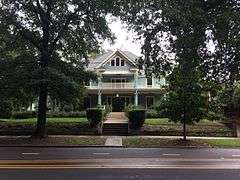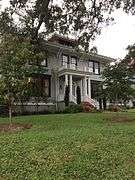Trinity Historic District
Trinity Historic District, also called Trinity Park, is a national historic district and residential area located near the East Campus of Duke University in Durham, North Carolina.[2] The district encompasses 751 contributing buildings in a predominantly residential section of Durham. They were built between the 1890s and 1960 and include notable examples of Queen Anne and Bungalow / American Craftsman style architecture. Located in the district are the separately listed "Faculty Row" cottage: the Bassett House, Cranford-Wannamaker House, Crowell House, and Pegram House. Other notable buildings include the George W. Watts School (1917), Julian S. Carr Junior High School (1922), Durham High School (1923), Durham Alliance Church (1927), Trinity Presbyterian Church (1925), Great A & P Tea Company (1927-1929), Grace Lutheran Church (c. 1950), and the former Greek Orthodox Community Church (c. 1950).[3][4][5]
Trinity Historic District | |
 The King's Daughters Inn, May 2011 | |
  | |
| Location | Roughly bounded by Green, Duke, Morgan, and W. Main Sts., Markham Ave., and Clarendon St.; also roughly bounded by the original Trinity Historic District, N. Buchanan Boulevard, W. Club Boulevard, Woodland Dr., and N. Duke St.; also 209-215 N. Gregson St., Durham, North Carolina |
|---|---|
| Coordinates | 36°00′22″N 78°54′43″W |
| Area | 281.9 acres (114.1 ha) |
| Built | 1890 |
| Architect | Barton, Harry; Davis, Archie Royal; Et al. |
| Architectural style | Late 19th And 20th Century Revivals, Bungalow/craftsman, Queen Anne |
| MPS | Durham MRA |
| NRHP reference No. | 86000672, 04000568, 07001372[1] |
| Added to NRHP | March 26, 1986, June 4, 2004 (Boundary Increase), January 9, 2008 (Boundary Increase) |
It was listed on the National Register of Historic Places in 1986, with a boundary increases in 2004 and 2008.[1]
Gallery
References
- "National Register Information System". National Register of Historic Places. National Park Service. July 9, 2010.
- http://trinitypark.org/history/
- Claudia Roberts Brown (June 1984). "Trinity Historic District" (pdf). National Register of Historic Places - Nomination and Inventory. North Carolina State Historic Preservation Office. Retrieved 2014-11-01.
- M. Ruth Little (December 2003). "Trinity Historic District (Boundary Increase)" (pdf). National Register of Historic Places - Nomination and Inventory. North Carolina State Historic Preservation Office. Retrieved 2014-11-01.
- Heather Wagner (July 2007). "Trinity Historic District (Boundary Increase)" (pdf). National Register of Historic Places - Nomination and Inventory. North Carolina State Historic Preservation Office. Retrieved 2014-11-01.






